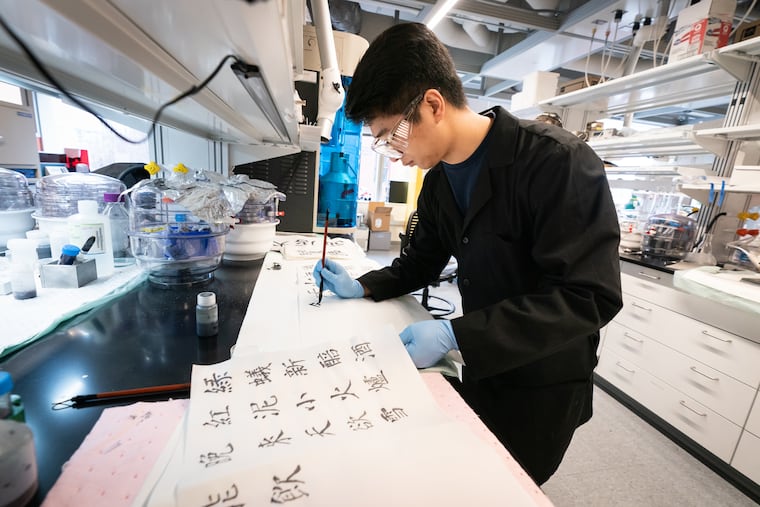An ancient art form got a new twist from this Drexel engineering student, 7,000 miles from his home in China
A new ink for Chinese calligraphy was made from metallic materials called MXenes, discovered by Drexel University engineers.

Drexel University engineering student Teng Zhang took up Chinese calligraphy recently, seeking a connection with family members in China whom he has not seen since before the COVID-19 pandemic.
But as often happens with beginning calligraphers, he struggled when using diluted, lighter-hued inks, watching in dismay as the colors bled through his porous, gossamer-thin paper.
The solution to Zhang’s blurry brushstrokes, he realized, lay in engineering. With Lunar New Year approaching, the Ph.D. student tried in December to make ink using tiny flakes of a high-tech, metallic material that his boss, Drexel professor Yury Gogotsi, had invented a decade earlier.
Bingo. The inks Zhang made from these materials, called MXenes, produced strokes with razor-sharp edges — a modern twist on an art form that is thousands of years old.
“People are always trying to describe what is tradition,” he said. “We are creating a new tradition for the future.”
Like papier-mâché
Gogotsi invented MXenes (pronounced maxenes) with Drexel colleague Michel Barsoum in 2011, naming them for a metallic component M, such as titanium, and a secondary element X, such as carbon. He now has more than 40 researchers, including Zhang, busily developing new uses for the materials in his lab on Chestnut Street.
Commercialization is still in the early stages, but so far MXenes have shown promise in making energy-storage devices called capacitors, thin films for shielding phones and other electronic devices from interference, and inks for printing flexible electronic circuits, according to an October review in Nature Nanotechnology.
Those applications are possible because MXenes conduct electricity.
When Zhang uses MXenes to make calligraphy ink, on the other hand, he prizes them for a different property. Mixed in water, the thin flakes of metallic material stick to each other like sheets of paper in papier-mâché, resulting in ink that holds a nice, tight line — even when diluted to make delicate shades of grey.
In a lab crammed with high-tech equipment, the calligraphy ink is, by far, the lowest-tech application. But Gogotsi, director of the A.J. Drexel Nanotechnology Institute, is delighted.
“It’s important for science, developing creativity,” he says. “Art and science are related.”
‘Feeling the beauty’
Growing up in the city of Xuzhou, in Jiangsu province in eastern China, Zhang was interested more in martial arts than in calligraphy, despite the urging of his father, a skilled practitioner of the traditional art form.
Yet in November, looking for a way to pass the time outside of work, he decided to give calligraphy another try.
Zhang purchased a bottle of traditional Chinese ink, made of the black residue from burning the oil or resin from a pine tree, and started practicing the graceful strokes. But when he diluted the ink to make various shades of gray, his brushstrokes had fuzzy edges.
Then he remembered a curious detail from the lab. Whenever he wiped up small spills of MXene-based fluids, the dark blotches did not bleed on his paper towel, instead forming a tight circle. Why not try it as a calligraphy ink?
Sure enough, when Zhang dipped his brush into the liquid, he produced Chinese characters with razor-sharp edges. What’s more, the ink dried with an attractive metallic sheen.
“I’m feeling the beauty of the art,” he said.
One day recently in the lab, Zhang spread out a wide sheet of white paper on a countertop to demonstrate his newfound craft. With deft strokes, he wrote to a friend about how they should get together for a drink on a cold, wintry evening.
Could his discovery represent a new commercial opportunity? Hard to say, as many Chinese calligraphers are wedded to tradition, Zhang said. Still, when he sent a picture of his handiwork to his family members, they called it “very interesting,” he said.
For the moment, MXenes are drawing more attention for their potential in various high-tech applications.
Certain formulations are being tested in sensors to measure human vital signs, either embedded in functional fabrics or printed directly on the skin. The high-tech substances also can be used to shield a person’s wallet or cell phone from electronic snooping. Still other types of MXenes are being tested in fabrics that would render the wearer invisible to infrared night-vision goggles, Gogotsi said. The Drexel professor said he is discussing that potential with representatives from the U.S. military.
Zhang and his lab mates contribute by analyzing the electrical properties of the materials and testing ways to tweak them.
He also plans to keep using MXene-based ink for his new hobby, which helps him feel closer to family members 7,000 miles away.
“It came out of my heart spontaneously,” he said. “I feel a connection to the family where I came from.”